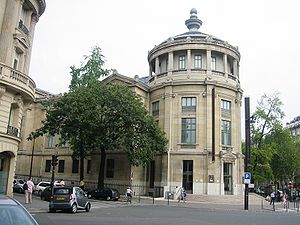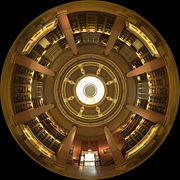
Guimet Museum
Encyclopedia

Asian art
Asian art can refer to art amongst many cultures in Asia.-Various types of Asian art:*Afghan art*Azerbaijanian art*Balinese art*Bhutanese art*Buddhist art*Burmese contemporary art*Chinese art*Eastern art*Indian art*Iranian art*Islamic art...
located at 6, place d'Iéna in the 16th arrondissement
XVIe arrondissement
The 16th arrondissement of Paris is one of the 20 arrondissements of Paris, the capital city of France...
of Paris
Paris
Paris is the capital and largest city in France, situated on the river Seine, in northern France, at the heart of the Île-de-France region...
, France
France
The French Republic , The French Republic , The French Republic , (commonly known as France , is a unitary semi-presidential republic in Western Europe with several overseas territories and islands located on other continents and in the Indian, Pacific, and Atlantic oceans. Metropolitan France...
. It has one of the largest collections of Asian art outside Asia
Asia
Asia is the world's largest and most populous continent, located primarily in the eastern and northern hemispheres. It covers 8.7% of the Earth's total surface area and with approximately 3.879 billion people, it hosts 60% of the world's current human population...
.
The museum which was first located at Lyon
Lyon
Lyon , is a city in east-central France in the Rhône-Alpes region, situated between Paris and Marseille. Lyon is located at from Paris, from Marseille, from Geneva, from Turin, and from Barcelona. The residents of the city are called Lyonnais....
in 1879 and was handed over to the state and transferred to Paris in 1885, was founded by Émile Étienne Guimet
Émile Étienne Guimet
Émile Étienne Guimet was a French industrialist, traveler and connoisseur.He was born at Lyon and succeeded his father in the direction of his "artificial ultramarine" factory...
, an industrialist. Devoted to travel, Guimet was in 1876 commissioned by the minister of public instruction to study the religions of the Far East
Far East
The Far East is an English term mostly describing East Asia and Southeast Asia, with South Asia sometimes also included for economic and cultural reasons.The term came into use in European geopolitical discourse in the 19th century,...
, and the museum contains many of the fruits of this expedition, including a fine collection of Chinese and Japanese porcelain
Porcelain
Porcelain is a ceramic material made by heating raw materials, generally including clay in the form of kaolin, in a kiln to temperatures between and...
and many objects relating not merely to the religions of the East but also to those of Ancient Egypt
Ancient Egypt
Ancient Egypt was an ancient civilization of Northeastern Africa, concentrated along the lower reaches of the Nile River in what is now the modern country of Egypt. Egyptian civilization coalesced around 3150 BC with the political unification of Upper and Lower Egypt under the first pharaoh...
, Greece
Greece
Greece , officially the Hellenic Republic , and historically Hellas or the Republic of Greece in English, is a country in southeastern Europe....
and Rome
Rome
Rome is the capital of Italy and the country's largest and most populated city and comune, with over 2.7 million residents in . The city is located in the central-western portion of the Italian Peninsula, on the Tiber River within the Lazio region of Italy.Rome's history spans two and a half...
. One of its wings, the Panthéon Bouddhique
Panthéon Bouddhique
The Panthéon Bouddhique, also known as the Galeries du Panthéon Bouddhique or the Galerie du Pantheon Bouddhique du Japon et de la Chine, is a museum of Japanese and Chinese art works...
, displays religious artworks.

Kabul Museum
The National Museum of Afghanistan , also known as the Afghan National Museum or the Kabul Museum, is a two-story building located 9 km southwest of the center of Kabul City in Afghanistan. It was built in 1922 during the reign of King Amanullah Khan...
, with archaeological pieces from the Greco-Bactrian city of Ai-Khanoum
Ai-Khanoum
Ai-Khanoum or Ay Khanum , was founded in the 4th century BC, following the conquests of Alexander the Great and was one of the primary cities of the Greco-Bactrian kingdom...
, and the Indo-Scythian treasure of Tillia Tepe
Tillia tepe
Tillya tepe, Tillia tepe or Tillā tapa or is an archaeological site in northern Afghanistan near Sheberghan, surveyed in 1979 by a Soviet-Afghan mission of archaeologists led by Victor Sarianidi, a year before the Soviet invasion of Afghanistan.The hoard is a collection of about 20,000 gold...
.

